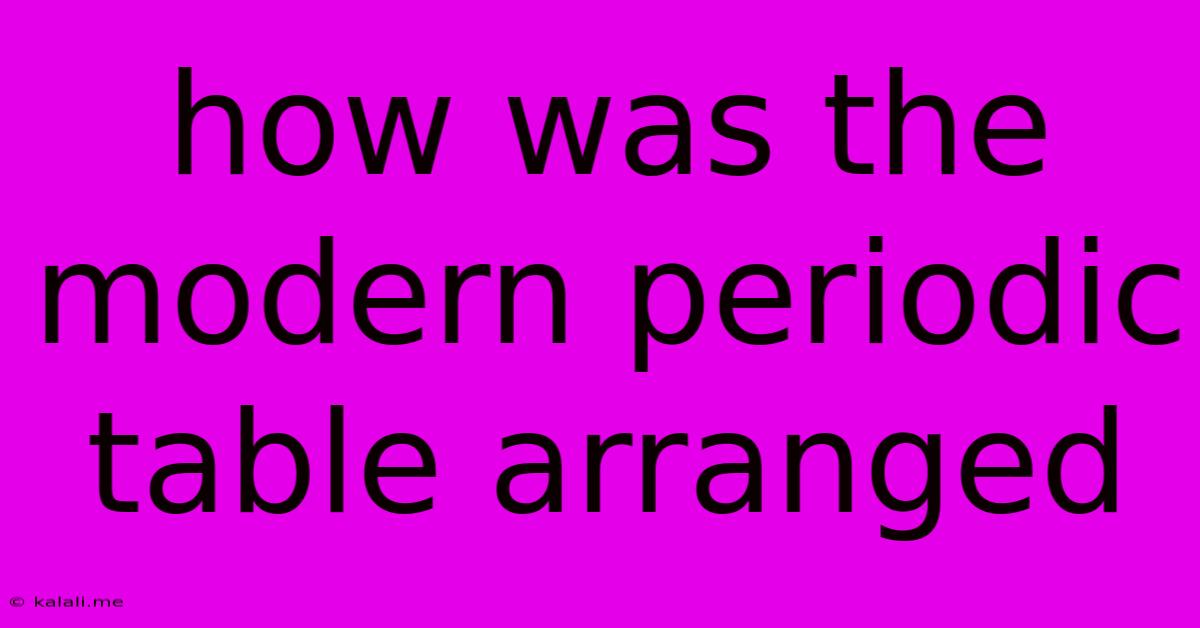How Was The Modern Periodic Table Arranged
Kalali
May 09, 2025 · 3 min read

Table of Contents
How Was the Modern Periodic Table Arranged? A Journey Through Chemical Organization
The modern periodic table, a cornerstone of chemistry, didn't spring into existence overnight. Its elegant arrangement, showcasing the periodic trends of elements, is the culmination of decades of scientific discovery and ingenious organization. This article delves into the fascinating history and evolution leading to the table we know and use today. Understanding its creation helps appreciate its power in predicting chemical behavior and fostering further scientific advancements.
From Early Attempts to Mendeleev's Breakthrough
Early attempts to organize elements focused primarily on atomic weight. Scientists noticed recurring patterns in element properties but lacked a comprehensive framework. Johann Wolfgang Döbereiner's "triads," grouping elements with similar properties, were an early step, but they were limited in scope. John Newlands' "Law of Octaves," noting that properties repeated every eighth element, was also insightful but lacked predictive power and didn't account for all known elements.
The true breakthrough came with Dmitri Mendeleev in the 1860s. Mendeleev arranged elements in order of increasing atomic weight, but crucially, he also prioritized periodic trends in chemical and physical properties. He recognized that elements with similar properties appeared at regular intervals. This led him to create a table where elements were arranged in rows (periods) and columns (groups) based on their shared characteristics.
Mendeleev's Genius: Leaving Gaps and Predicting Elements
Mendeleev's brilliance wasn't just in arranging known elements. He boldly left gaps in his table for elements he predicted would be discovered, with properties he accurately forecasted based on their position. These predictions were stunningly accurate, further validating his organizational scheme. The discovery of gallium, scandium, and germanium, with properties matching Mendeleev's predictions, cemented the table's credibility and fueled further research.
The Role of Atomic Number
While Mendeleev's table was a monumental achievement, it had limitations. Some elements didn't perfectly align with the increasing atomic weight order. This was resolved with the discovery of the atomic number, the number of protons in an element's nucleus, by Henry Moseley in the early 20th century. Rearranging the table by atomic number instead of atomic weight completely resolved the inconsistencies and provided a more accurate reflection of elemental properties and relationships.
The Modern Periodic Table: A Dynamic System
The modern periodic table we use today arranges elements based on increasing atomic number, reflecting the fundamental structure of atoms. Elements are grouped into periods and groups based on their electron configurations, directly influencing their chemical behavior. The table isn't static; new elements continue to be synthesized and added, extending its reach and refining our understanding of matter.
Key Features of the Modern Periodic Table:
- Periods: Horizontal rows representing energy levels of electrons.
- Groups: Vertical columns showcasing elements with similar chemical properties, primarily determined by their valence electrons.
- Metals, Nonmetals, and Metalloids: Elements are classified into these categories based on their properties.
- Transition Metals: Occupying the central block, exhibiting diverse oxidation states.
- Lanthanides and Actinides: Two rows placed separately, representing the f-block elements.
The journey from early attempts to the modern periodic table is a testament to the power of observation, prediction, and the relentless pursuit of scientific understanding. It's a powerful tool, not only for organizing chemical knowledge but also for predicting and understanding chemical behavior, paving the way for countless innovations in science and technology.
Latest Posts
Latest Posts
-
Plants Need This To Produce Their Own Food And Energy
May 10, 2025
-
Which Layer Of The Earth Is Most Dense
May 10, 2025
-
30 Is What Percent Of 64
May 10, 2025
-
Least Common Multiple Of 5 And 12
May 10, 2025
-
How Much Is 53 Cm In Inches
May 10, 2025
Related Post
Thank you for visiting our website which covers about How Was The Modern Periodic Table Arranged . We hope the information provided has been useful to you. Feel free to contact us if you have any questions or need further assistance. See you next time and don't miss to bookmark.